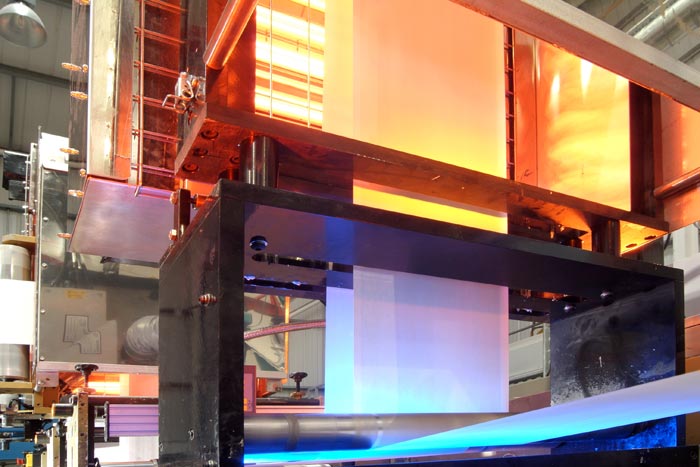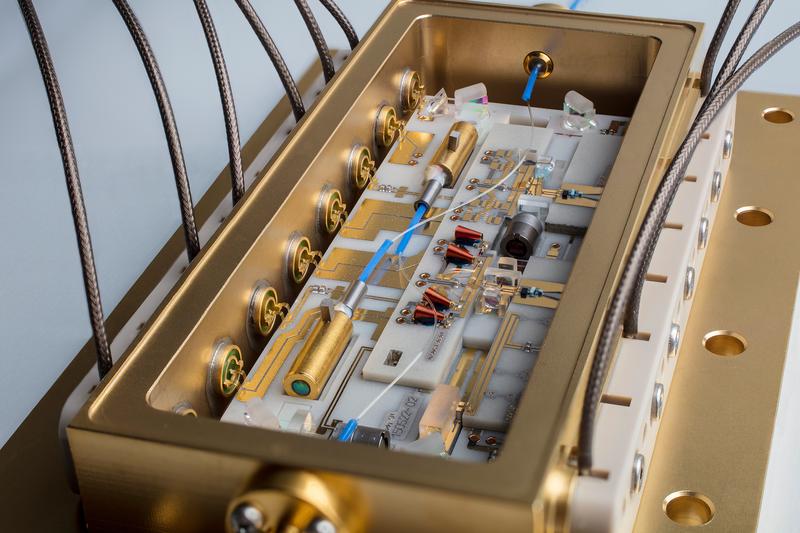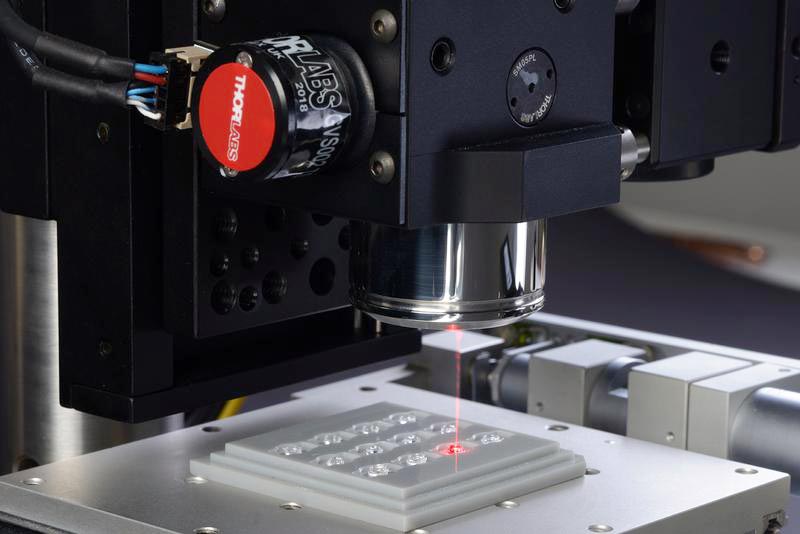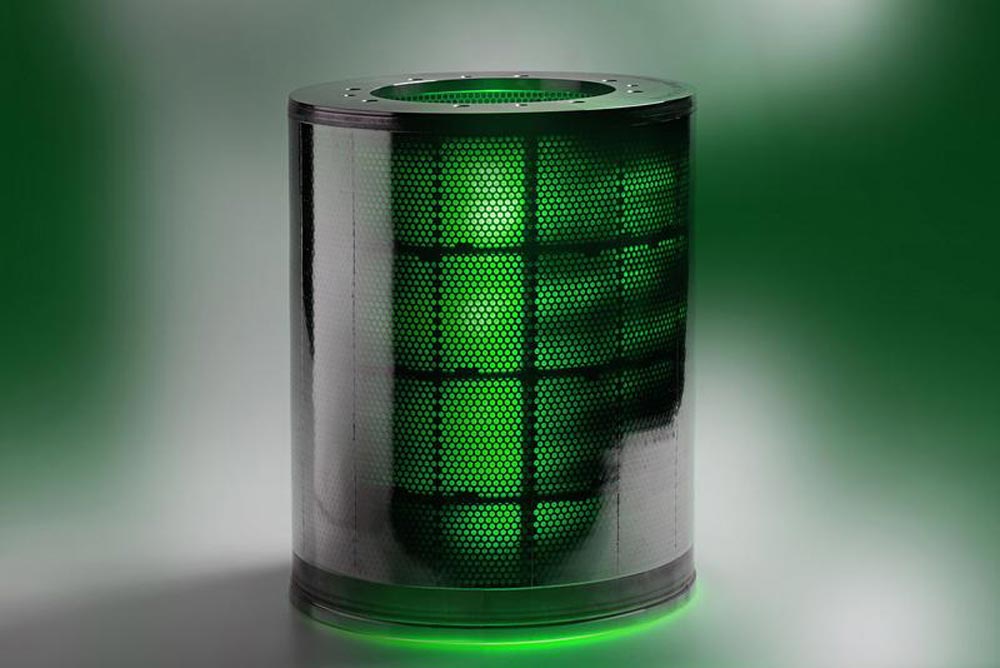

UV radiation cures, infrared heat dries – tests in Application Competence Centers help find the parameters for this.
(Copyright: Heraeus Noblelight, Hanau 2015)
At the European Coatings Show in Nuremberg in April, Heraeus Noblelight will present application-optimised UV lamps, UV-LED systems and infrared heating solutions for efficient ink curing. Application examples show when it makes sense to combine UV and IR and which parameters need to be considered.
Efficiently cross-linked with optimal use of energy
In a UV curing process – polymerisation – photoinitiators are activated by intensive UV light and cross-linked within seconds This quickly cures the material and the surface is dry, abrasion-proof and immediately ready for the next processing steps. Inks and coatings also remain permanently scratch-resistant and attractive when they are optimally and sufficiently cured. Wavelength, UV light intensity and dose must be adjusted to the photoinitiators of the ink formulation or coating.
Heraeus Noblelight offers different UV solutions for the pretreatment or curing of inks and coatings. The range includes innovative LED technology, special surface lamps (UVC Cure) or conventional UV medium-pressure lamp systems as well as microwave-powered UV lamp systems. Depending on the curing process, material and coating, ink or paint formulation, the UV radiation is adjusted to the individual process requirements.
The different UV systems emit intensive UV light in the wavelength range of 200 to 400 nanometres. The wavelengths of the lamps are optimised for the photoinitiators of the ink system or coating to achieve efficient and sufficient cross-linking. This enables higher production speeds and improved process reliability. At the end of a curing process, the surface can be processed without much delay and obtains scratch-resistant and durable qualities.
From beginning to end: Heraeus UV radiation sources accompany the entire production process
Prior to application of the coating or printing, the surface tension can be reduced and the surface energy increased by means of VUV radiation (vacuum UV). Due to the changed wetting properties that result, materials can be further processed better and faster. After that, the UV coating or printing is cured. Intensive microwave-powered UV medium-pressure systems with appropriate doping or UV-LED systems are used for this. The selection of a suitable UV solution also allows intermediate curing steps. Finally, the surface can be further improved by means of a special UVC Cure system. Similar to UV-LEDs, the system emits monochromatic UV radiation in the UVC range. This makes surfaces significantly more scratch-resistant.
Depending on the process step, different Heraeus UV solutions can be used. The use of advanced UV-LED technology is a promising option for lowering energy consumption and heat input. UV-LEDs are ozone-free and long-lasting. This makes maintenance easy and saves money. The current developments of UV-LED coatings and paints enable curing with UV-LEDs despite the monochromatic spectrum. Conventional UV technologies such as UV medium-pressure lamp systems dry and cure paints across a wide, polychromatic spectrum with a very high intensity. This allows high speeds and reliable curing processes.
Infrared emitters dry water-based coatings quite efficiently
A carbon infrared system from Heraeus Noblelight helps meet the quality requirements for coated tablet pads in aircraft. The anti-slip coating is a water-based solution which is applied to mats of paper and then needs to be dried as quickly as possible – a task efficiently achieved with high quality carbon infrared emitters.
Extensive trials have shown that a carbon infrared emitter consumes up to 30% less energy for the drying process than a conventional short-wave infrared emitter.
All carbon emitters combine efficient medium-wave radiation with high power density and expedite the drying of water-containing paints and inks with high efficiency.
The wavelength of the infrared radiation has a major influence on the thermal process. Water evaporates quite quickly when exposed to medium-wave infrared radiation. The reason for this is that medium-wave radiation is very well absorbed in water and directly converted into heat, in contrast to very short-wave, near-infrared radiation.
Infrared heat has already proven itself in the drying of coatings, as infrared radiation penetrates deeply into the material (more or less, depending on the paint system) and dries the paint film from the inside to the outside. Skin or bubble formation on the surface is prevented and the paint dries faster. The result is a brilliant surface quality. With the help of electromagnetic waves which generate heat only within the material, infrared emitters transmit heat efficiently and without contact . In contrast to hot air, this minimises the adherence of disturbing particles in the sensitive paint during drying.
When does the combination of infrared heat and UV technology make sense?
Heat improves the mobility of molecules and hence the result of the curing reaction. Some processes transmit very little heat into the paint materials, e.g. when the are running very fast. However, this may have a negative effect on adhesion and durability. UV curing is a chemical cross-linking process. By preheating the substrate with infrared radiation, adherence and cross-linking of the UV-curing paint are improved. It has proven advantageous to specifically heat materials prior to UV cross-linking.
Moreover, infrared heat is used to drive out the solvents from high-gloss UV paints prior to curing.
This has proven particularly efficient in modern water-based UV wet coatings, where infrared heat is used to evaporate water, so that UV radiation can then optimally cross-link the paint.
Combining IR and UV makes sense when energy savings or excellent quality is required. The innovative combination of infrared heat and UV technology not only improves the energy efficiency of the IR paint curing but also optimises the cross-linking of UV paints.
Heraeus, the technology group headquartered in Hanau, Germany, is a leading international family-owned company formed in 1851. We create high-value solutions for our customers, strengthening their competitiveness for the long term. Our activities focus on a number of markets: chemical and metals, energy and the environment, communications and electronics, health, mobility, and industrial applications. In fiscal year 2013, Heraeus achieved product revenue of €3.6 billion and precious metals trading revenue of €13.5 billion. With some 12,500 employees in over 110 subsidiaries worldwide, Heraeus holds a leading position in its global markets.
Heraeus Noblelight GmbH with its headquarters in Hanau and with subsidiaries in the USA, Great Britain, France, China and Australia, is one of the technology- and market-leaders in the production of specialist light sources and systems. In 2013, Heraeus Noblelight had an annual turnover of 138 Million € and employed 875 people worldwide. The organization develops, manufactures and markets infrared and ultraviolet emitters, systems and solutions for applications in industrial manufacture, environmental protection, medicine and cosmetics, research, development and analytical measurement techniques.
For more information, please contact:
Technical : Heraeus Noblelight GmbH
Heraeusstr. 12-14
D-63450 Hanau
Tel +49 6181/35-4499, Fax +49 6181/35-9926
E-Mail hng-uv@heraeus.com
Press: Juliane Henze
Heraeus Noblelight GmbH,
Abteilung Marketing/Werbung
Tel +49 6181/35-8539, Fax +49 6181/35-16 8539
E-Mail juliane.henze@heraeus.com












